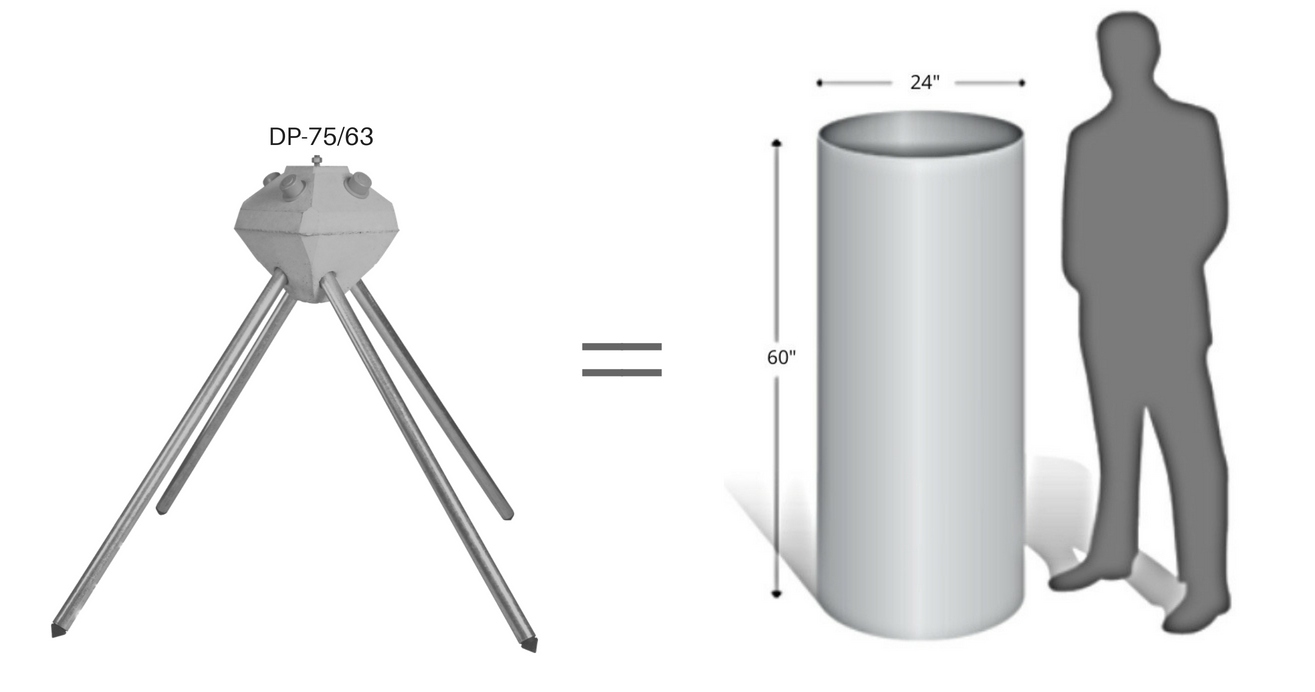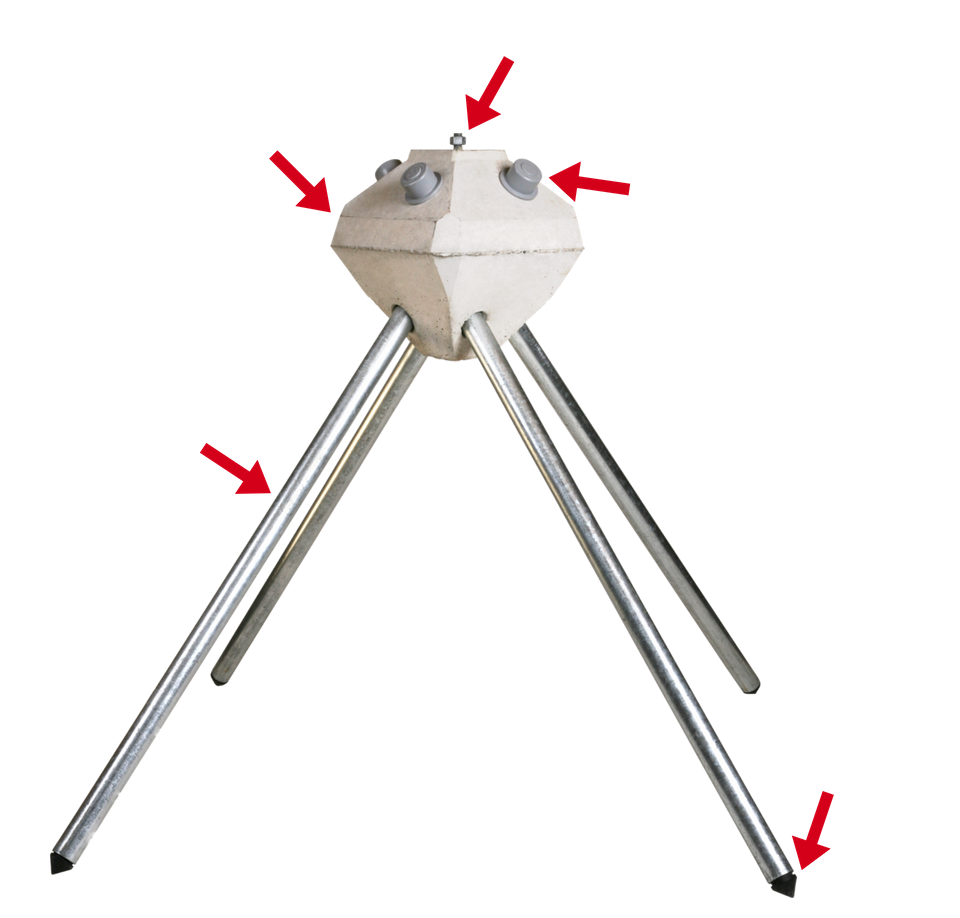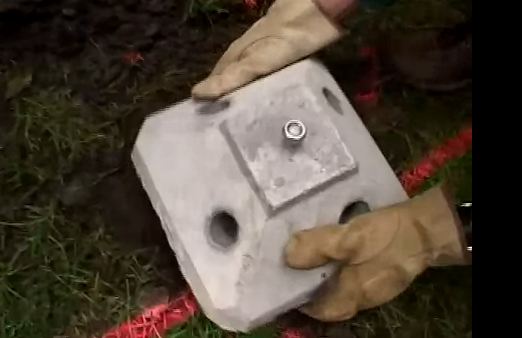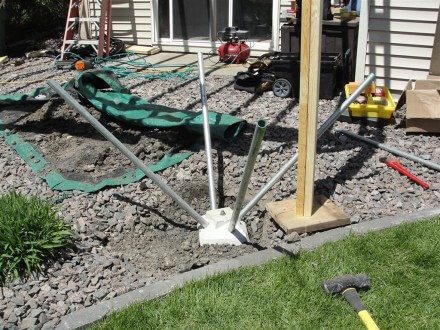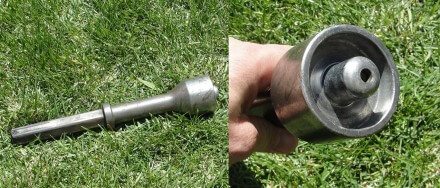- How It Works
- Understanding Diamond Pier & Pin Pile Technology
- Emulating Nature’s Perfect Design
- Diamond Pier Equivalency
- Diamond Pier footings are an equivalent alternative to traditional concrete piers.
- The Diamond Pier Foundation System
- Фундаменты
- Diamond Pier Foundation Systems
- Instant Piers for Your Front Porch Or Deck
- Diamond Pier Foundation System Footings
- More Porch Foundation Information
- A New Type of Deck Footing: Diamond Piers
- Older Post
- Newer Post
How It Works
Understanding Diamond Pier & Pin Pile Technology
Pin Foundations, Inc., manufacturer of the Diamond Pier, has been designing and manufacturing foundations for over 25 years. One thing has always driven our thinking; The Earth is the actual foundation, and soils, in their natural undisturbed state, have the strength and structure to do the job.
That’s why the Diamond Pier is based on Pin Pile Technology. Pilings keep the Earth’s existing soil strength and structure intact, and are easy to install if they do not need to go too deep. Traditional footings spread loads more widely, but the digging breaks apart the soil, weakening it and blocking or exaggerating water flow.
By grouping short bearing pins, which can easily be driven into intact penetrable soils, and setting them at angles to work more like a shallow footing, a sound foundation can be constructed that requires no excavation.
Emulating Nature’s Perfect Design
- Like tree roots, Spread Pile Engineering transfers the load of your project to a greater area of soil below. The pins lock, preventing the head from moving up and down.
- Uplift resistance forces frost heaved soils to cleave around the head.
- Bearing forces spread out in an A-shaped cone distributing load over a greater area of undisturbed soils
Diamond Pier Equivalency
Diamond Pier footings are an equivalent alternative to traditional concrete piers.
DP-50/50 = A Diamond Pier DP-50/50 will support up to the same load as a 20″ x 48″ traditional concrete footing in 2000 psi soils.
DP-75/63 = A Diamond Pier DP-75/63 will support up to the same load as a 24″ x 60″ traditional concrete footing in 2000 psi soils.
See the Diamond Pier Load Chart for a full look at Diamond Pier’s Equivalency.
The Diamond Pier Foundation System
PFI’s innovation is to bring pin pile technology into common use with a superior connector—the Diamond Pier concrete head. This high-strength, precast component is a driving guide, a pin piling lock, and a structural connection all in one.
As a driving guide, the pier maintains the pin angles so that their capacity is definable and consistent. As a lock, the pier is designed to increase its grip on the pin cluster when loaded up, down, or side- ways—getting stronger and tighter as loads increase. And as a connection, an embedded anchor bolt and precast, post-matching shape make it a simple and proportional complement to its supported structure.
The Diamond Pier provides a solid, stable, economical foundation that both captures and preserves the supporting strength and natural functions of the Earth’s soil and, in turn, solidly and simply connects to and protects the permanent structures above.
Источник
Фундаменты

В типичных случаях применяются винтовые сваи со способностью переноса нагрузок от 10 до 20 тонн. Эта система является единственной в США, которая прошла сертификацию и получила подтверждение соответствия всех национальных органов стандартизации в строительстве. Систему можно применять как в работах по восстановлению и ремонту фундаментов, так и при сооружении новых. Одним из наиболее детально разработанных элементов является пневматическая установка для подъема и регулировки фундаментов, исключительно полезная при ремонте и восстановлении поврежденных фундаментов. Установка трансформирует структурные нагрузки на нижележащие упругие слои грунта. Она может также применяться при сооружении новых фундаментов.
Там, где нагрузки строения на геооснову не являются столь большими можно применять систему Pin Foundation System, которая состоит из следующих систем: Speed Pile System, Butterfly System, Diamond Pier, FootPrint System. Собственно говоря, система Butterfly не является фундаментной, ибо ее предназначением является поддержка легких конструкции типа мостиков, террас, патио на вязких и неоднородных грунтах. Наиболее технически продвинутой является система FootPrint, предназначенная для сооружения ленточных фундаментов. Она создает возможность сооружения фундамента без каких-либо земельных работ, оставляя даже не тронутым растительный ковер. Система Speed Pile применяется при постройке деревянных каркасных домов и вообще не требует сооружения бетонного или кирпичного фундамента.
Система Diamond Pier состоит из характерной по форме бетонной подпоры с четырьмя отверстиями для введения свай, притом в зависимости от предусмотренных проектом нагрузок забивают две или четыре сваи. Бетонную форму предварительно размещают в небольшой яме, выкопанной обычной лопатой. Особая форма подпоры создает условия для скольжения вокруг нее грунта, благодаря чему не подвергается морозному вспучиванию. Длина свай составляет от 1,3 до 2,7 м. Все вышеперечисленные системы имеют американские патенты (некоторые также и канадские). Единственным ограничением в приме нении систем при сооружении фундаментов является болотный грунт со стоячей водой. В таком случае рекомендуется применять систему CHANCE Helical Pier.
В ? 6 2000 в статье «Защита фундаментов от промерзания» мы уже писали о системе сооружения фундаментов Form-A-Drain, производимых фирмой CertainTeed, как одном из способов их быстрого выполнения. Этот принцип был положен во главу угла при разработке других систем выполнения фундаментных работ, пользующихся заслуженным спросом среди строителей. Первая система Adjust-a-Form была разработана фирмой Azar Group. В ее состав входят три виды систем для быстрого выполнения фундаментных работ: Adjust-A-Form Fixed Length Forms, в которой длина форм съемной опалубки фундамента является постоянной; Adjust-A-Form Telescopic System, в которой длина формы регулируется путем выдвижения одной части формы из другой; Flex-A-Form — форма, создающая возможность быстрого выполнения фундаментов мелкого заложения по любой кривой линии. Вторая система Fastfoot принадлежит фирме Fastfoot Industries Ltd. Эта система является по мнению экспертов, несмотря на ее простоту, наиболее интересным и технологически оригинальным способом закладки фундаментов.
Наибольший интерес и довольно широкое применение она нашла в среде строителей модульных и мануфактурных домов, а также домов, воздвигаемых по технологии несъемной опалубки. Изобретенная два года назад, эта технология нашла, в последнее время еще одну сферу применения — при сооружении фундаментов под опорные стены вдоль железнодорожных путей. Эффективность ее применения растет в зависимости от сводной суммы длины ленточного фундамента. Опыт показал, что трое рабочих могут в течение одного часа заложить фундамент длиной в 30 метров, то есть заложение фундамента под дом 15×15 м займет примерно два часа. Это система несъемной опалубки, в качестве которой впервые в фундаментных работах, применяется не дерево или металл, а специальная импрегнированная полиэтиленовая ткань.
Ткань поставляется в рулонах длиной 30 м и шириной 1320 мм. Вторым элементом системы являются скобы (хомуты), в которые вставляются деревянные или алюминиевые планки сечением 50×100 мм. Скобы имеют приспособления, благодаря которым существует возможность регуляции уровня и высоты. С помощью популярных сегодня лазерных нивелиров достигается идеальная горизонтальность фундамента. Благодаря свой ству ткани приобретать любую форму, технология допускает неравномерности грунта до 30 см.
Строительным степлером ткань крепится к деревянным планкам, служащим впоследствии шаблоном для сооружаемых стен. Спустя сутки, в случае дальнейшего использования деревянных планок, их прибивают к свежему еще бетону. В стандартном исполнении высота фундамента может достигать 460 мм. Технически максимальная высота может достигать 1320 мм. Опыт применения этой технологии содействовал разработке технологии возведения стен с использованием полиэтиленовой ткани в качестве опалубки. Для строителей модульных домов еще более интересным является технология «столбчатого» фундамента. В ней используется б размеров полиэтиленовых подушек, размером от 460 мм до 1220 мм. В случае необходимости вовнутрь подушки закладывается стальная арматура. Через отверстие в верхней части подушки заливается бетонная масса.
Высоту бетон ной подушки регулируют количеством заливаемой бетонной массы. Другие аналогичные системы, как, например, система PacForm фирмы Pacific Wood Laminates или система Stay-Form фирмы Alabama Metal Industries используют принцип несъемной опалубки (соответственно деревянной и металлической). Независимо от технологических различий все они призваны решить одну и ту же задачу — ускорить процесс выполнения фундамента при минимизации финансовых издержек, количества отходов и малым числом рабочих. Рост интереса к этим системам связан с ростом интереса к нетрадиционным технологиям домостроения, речь о которых шла в разделе «Строительные технологии».
Здесь наглядно прослеживается логика развития строительной индустрии как одного целого. Допустимость всех новшеств в технологии закладки фундаментов связана прежде всего с тем, что здания и сооружения, не теряя своих прочностных характеристик, становятся все легче. К этому ведет постепенная элиминация минеральных материалов и дерева, заменяемых композитными материалами.
Что касается России, то фундаментостроение остается в плену представления о том, что такое солидный дом «на века». Не связанное с прочностными характеристиками строений, чрезмерное применение и перенасыщение его минеральными (кирпич, камень, бетон) составляющими ведет к увеличению нагрузки на грунт и тем самым — повышенным требованиям к фундаменту. Нередки случаи, когда под фундамент обычного двухэтажного дома ищут аэродромную плиту или советуют рыть котлован чем глубже, тем лучше.
Качество фундамента во многом зависит от качества бетонной массы. В этой области заслуживают всяческой поддержки разработки российских фирм, из которых следовало бы указать на санкт-петербургскую фирм)Business&Building Systems Group SPB, внедряющей в строительную практику инновационные системы и материалы для высококачественных бетонов (Монофлоор С, Фибрин, Химстайн, Джемсил, Permocolor, Paverseal и другие). Московская фирма ВЮТЕХ продвигает добавки Лигнопан серии Б-1, Б-2, Б-3 и Б-4. Очень активно ведет работу Научно-исследовательский проектно-конструкторский и технологический институт бетона и железобетона (НИИЖБ), особенно в области добавок для бетона. Объединение МИСИ-КБ разработало систему комплексного технологического обеспечения обогрева и выдерживания бетона КТООБ.
Источник: Журнал «Профессиональное строительство», N2(12), март-апрель 2001 г.
Источник
Diamond Pier Foundation Systems
Instant Piers for Your Front Porch Or Deck
We discovered Diamond Pier Foundation Systems recently and thought you might like this innovative foundation system. Digging holes to the required depths, especially into rock laden soil, can be difficult and time consuming.
There’s a better way.
If you like innovative products that will save you time check out the Diamond Pier Foundation Systems.
Diamond Pier Foundation System Footings
Green Building Technology — Diamond Pier by Pin Foundations
Diamond Pier Foundation System Footings
The process is much easier and faster than using the traditional method:
- Locate the bases at the right height
- Affix the steel tubes
- Cap them off
Green Building Technology — Diamond Pier by Pin Foundations
I’ve dug lots of footings to support porch and deck columns and am a stickler for ensuring they are deep enough and wide enough to support either the porch or deck. The better the foundation of a structure (that includes the footings and piers) the longer the structure will last.
And since I like doing things myself I usually over build. I’ve seen too many builders pour a bag of concrete in a hole and call it good. Footings need to be below the frost line for your geographical area. Otherwise, the freezing ground contracts and moves pushing the footing up. Over time this can destroy your foundation.
If digging holes for footings, splay the bottom of the hole so that it is wider than the remaining hole. This helps prevent the pier from being pushed upwards (like pulling a plug off the ocean bottom).
That’s another reason I think this system would work the same way. The posts driven into the earth at angles would result in the same effect as splayed concrete.
The only drawback may be the price which ranges anywhere from $110 to $190 per unit. Subtract your costs for concrete, labor, and time and it might just be worth the investment.
I haven’t had the opportunity to use the Pier Foundation System yet so send us your thoughts and critiques and we may pass them on to our site visitors.
More Porch Foundation Information
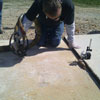
Источник
A New Type of Deck Footing: Diamond Piers
Goodbye post hole.
Goodbye post hole digger.
Goodbye worker bending over the hole.
Goodbye two-man auger,
and the gas that goes in it.
Goodbye concrete mix.
Goodbye wheel barrow.
and the rebar inside it.
Goodbye frost heave,
and Goodbye heaved steps.
Goodbye heaved footings,
and Goodbye heaved decks.
Goodbye to the homeowner
cursing «what a mess».
Goodbye waiting for concrete to cure.
and Goodbye waiting for footing inspections.
Goodbye old-school deck footings everywhere.
OK, I don’t really think standard footings are going to become a thing of the past just yet, but there’s a cool new product in town that’s making deck footings way faster and easier to install; it’s called a Diamond Pier® Foundation System.
A Diamond Pier is basically just a small piece of concrete with four holes in it. Long steel pins get driven through the holes at 45 degree angles, and these pins make the small chunk of concrete as strong as an 18″ round footing, assuming it’s the smallest Diamond Pier made, the DP-50. No joke.
When I first learned about this foundation system I could understand how this might be able to hold a lot of weight, but my real concern was with frost heave. As I mentioned in my blog post on frost heave and deck footings last week, frost heave can be a serious problem with decks here in Minnesota.
Diamond Pier foundation systems were introduced in to the residential market approximately ten years ago, and have been used in various cities here in Minnesota since 2007 to help gain ICC approval. Of the nine deck installations listed in Diamond Pier’s frost performance reports, four of the nine examples took place in Maple Grove. I spoke with two building officials at the City of Maple Grove who said that in all the cases that have been closely followed for the last five years, there was only one documented failure of a single footing, and it was more due to ‘user error’ than anything else; the homeowner had a downspout discharging right next to the footing (no-no).
My next door neighbors had a deck that heaved so badly last year that the patio door wouldn’t even open, and their deck stairway became downright scary to use because it was so badly tilted. They tore their deck down last month and had it re-built, this time with a Diamond Pier foundation system. The photo below shows one of the piers being installed; after digging out a little bit of rock and dirt, the pier gets placed in the earth.
To help keep the pier steady, the pins need to get tapped in to the earth a little bit with a drilling hammer or sledge hammer, but they’re not supposed to be fully driven in to the earth that way. A demolition hammer needs to be used in conjunction with a specialized driving bit, shown below, to drive the pins into the earth.
The video clip below shows the pier being installed, along with the coaching of local Diamond Pier rep Ralph Schmidt. First they tap the pins in to place, then drive them in using a demo hammer.
Diamond Piers are available in lumber centers throughout Minnesota, and I think they’re well worth the extra money when compared to the amount of work involved with standard footings. Prices vary, but Hamel Lumber sells the DP-50 for $115.75 each, and they offer free use of the driving bit if the pier footings are purchased from them.
After hearing the rave reviews of this product from contractors and building officials, I think I’m pretty much sold. If I ever have an upcoming project where these would make sense, I wouldn’t hesitate to try them. Diamond Piers can still experience frost heave, but they perform as well as or better than properly installed traditional footings. I’ll try to post follow-up photos of my neighbors’ deck each year on this blog post to show how the pier footings are holding up.




Older Post
Newer Post
Reuben Saltzman is a second-generation home inspector with a passion for his work. Naturally, this blog is all about home inspections and home-related topics in the Twin Cities metro area. In addition to working at Structure Tech, he is also a licensed Truth-In-Sale of Housing Evaluator in Minneapolis, Saint Paul and several other cities.
Источник

